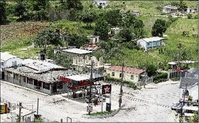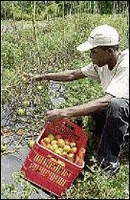Crisis in the countryside
Published: Sunday | June 7, 2009

An aerial view of the farming community of Cave Valley. - file photos
One of the most worrying features of our long-standing economic and social crisis has been the effects which this has had on Jamaican rural life. In the not-so-distant past, Jamaican village life was held up in sharp contrast to what was presented as the harshness and amorality of urban life - both inner city and uptown. Not any more. As the spread of criminality to parishes such as Clarendon and rural St James makes clear, forces are abroad in our countryside which are having an equally drastic effect on life there, although all is far from lost.
The most revealing part of this process has been the stagnation of our urban population. We know that, contrary to what many continue to think, the total population of Jamaica has been stuck at just under 2.7 million people since 2007. In 2003, our total population was 2.63 million and by 2008 it had barely increased to 2.69 million. The reason for this, of course, is that our birth and population growth rates have been declining steadily. From 1991, the population growth rate had fallen to less than one per cent annually and today (2008 data) it is way down there at the insignificant level of 0.4 per cent.
At the same time, it is striking that, contrary to all expectations (including mine) and to global trends in Latin America, sub-Saharan Africa and Asia, there has been a similar stagnation in the percentage of Jamaicans living in towns. In 1991, half of the Jamaican population was urban. Ten years later, in 2001, this number had barely crept up to 52 per cent. Today, eight years later, the urban population of Jamaica remains stuck at this same 52 per cent figure. In Latin America, the percentage of the population which is urban is 78 per cent - way above our levels. The rate of growth of our urban population between 1991 and 2001 was a measly 1.4 per cent. By 2007, this had declined further to 0.9 per cent annually.
In sub-Saharan Africa, the annual rate of growth of the urban population was 3.7 per cent in 2007. In Latin America and the Caribbean (including Jamaica), the urban population grew at an annual rate 1.7 per cent in 2007. It is clear from this data that Jamaica is bucking the global trend towards massive urban sprawl in one or two megacities and the sharp reduction of the rural population.
growth
What is even more interesting is that the absolute growth (as distinct from relative stagnation) in the urban population seems to be primarily due to a growth in the population in the 'Other Towns' category. One is talking about townships such as Santa Cruz and, of course, Ocho Rios, which have grown at a significant rate in the period. In fact, I am reliably informed that unemployment rates in these 'Other Towns' tend to be significantly lower than is the case in Kingston and St Andrew, and the same may follow for other social indicators.
To summarise, therefore: the data paint a picture of urban stagnation in Kingston and St Andrew and to a lesser extent Montego Bay, and to a rural population which continues to be stable at about 48 per cent of our total population. In so far as the urban population is growing, this growth seems to be taking place in smaller urban centres closely interconnected with rural life.
The relative stagnation of our urban population is connected with the long-standing stagnation of our national economy. What these population data reflect is the collapse of our efforts to develop a significant local manufacturing sector, following the rise of NAFTA and competition from Asia and also Central America. As employment opportunities have drastically declined in Kingston in particular, the population, which up until 1980s was streaming into the Corporate Area, got the message. What was the point of leaving one's rural district in which at least one could likely live rent free and have food to eat, to turn into a beggar in Kingston, cotching in some 'tattoo'?
But this is only one side of the coin. One must never forget that, harsh as urban conditions are, life remains much harder in the countryside. The overwhelming majority of persons who fall below the poverty line in Jamaica live in rural areas. Rural poverty tends to be deeper. Rural unemployment and underemployment, especially among youth and women, tend to be very high. So why aren't more people driven into the larger towns to take their chances?
We really do not know the answer to this question in the present state of research. In the meantime, I speculate that the following factors may well be at work. First of all, there was the bauxite-alumina industry. This has been overwhelmingly a rural industry which has been crucial for the standard of living for parishes such as St Elizabeth, Manchester, St Catherine and Clarendon. Second there were remittances. As we know, remittances increased to well over US$1 billion in the decade, with a substantial part of this flowing to the rural population. One only has to look at the proliferation of money transfer points in the countryside to see the importance of this source of income for maintaining country life.
Connected to this has been the growth of the rural informal transport sector. The 'deportee' phenomenon - also a product of the decade of the 1990s - has been an important area in which remittance money has been invested. Many more persons in the countryside own their own cars and pickup trucks than before. A number of these are used as taxis - in any Jamaican township of any size these rural taxis are ubiquitous. Moreover, a number of persons have gone further and been able to buy minibuses.
Some rural taxis and minibuses do relatively short trips to and from adjoining parishes, while others do longer haul trips to Kingston and Montego Bay. The upshot is that the rural population today is far more mobile than it was in the 1960s and 1970s. The construction of new road systems would have facilitated this even further. What is the point of moving to Kingston if one can live in Porus and go to work daily in Kingston, not to mention Mandeville? In a small island state like Jamaica, a significant improvement in mobility can have a powerful effect on urban-rural patterns of settlement.
cellphone usage
We also have to remember the spread of pipe-borne water in the countryside, of rural electrification (allowing more household appliances), and of cellphones. It would be interesting to take a look at cellphone usage in the countryside - I suspect that it has grown astronomically. All of this means that access to those services, which in the past required either moving to the Corporate Area or physically making a trip, can now be secured by phone. In other words, a number of developments in the last decade have substantially undermined the 'push' factors from the countryside.
Yet, the other side of the picture is clear. About 25 per cent of our population lives in squatter settlements - many of which are in rural or semi-urban areas. Remittances have declined by about 14 per cent. Bauxite-alumina revenue has collapsed by about 60 per cent. Domestic agriculture which is bouncing back, as it always does after a hurricane, is not an answer to this collapse.
A strong domestic agricultural sector is extremely important but the incomes from domestic agriculture still remain relatively low. The more we modernise domestic agriculture, the fewer people it will employ. Without doubt, therefore, we have a deep and urgent crisis in our countryside which has dire implications for the growth of rural starvation as well as rural criminality.
This goes way beyond what any ministry of agriculture could reasonably be expected to address effectively. We need a broad and comprehensive strategy for the countryside, and we need it now.
Feedback may be sent to columns@gleanerjm.com.

A farmer picks and sorts tomatoes for the market.
